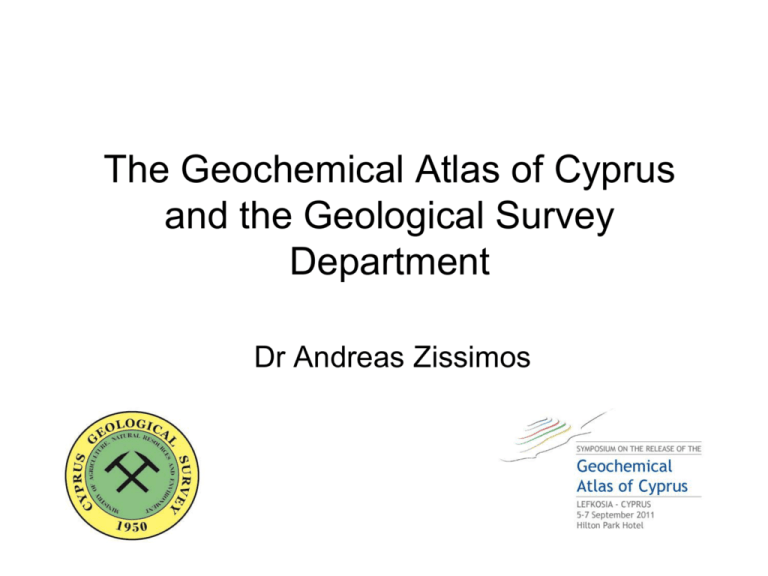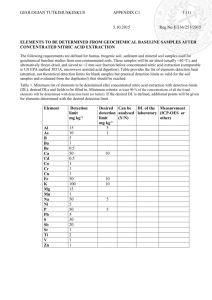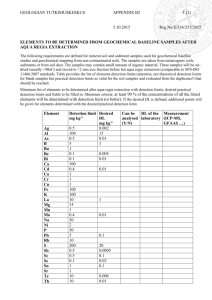Geochemical Mapping Methodologies and techniques
advertisement

The Geochemical Atlas of Cyprus and the Geological Survey Department Dr Andreas Zissimos Talk outline • • • • • • Why the necessity? Project Objectives / Structure Tender information Technical Considerations GSD contribution Results / Outcome In context… The primary purpose of geochemistry is to determine quantitatively the chemical composition of the Earth and its parts, and to discover the laws that control the distribution of the individual elements (Victor Goldschmidt 1937; 1954). Applied geochemistry is the application of this knowledge to societal benefit. Geochemical maps are schematic abstractions that greatly facilitate visualizing, understanding, and classifying complex spatial patterns, related to many underlying controlling factors. Why do we need to map chemical constituents in soil? • Exploration Tool Discovering mineral resources • Environmental purposes Protecting the surface environment that sustains life Improving the efficiency of agriculture and animal husbandry and protects one of the most important resources, underground water. • Health and medical purposes Studying the behaviour of elements in the food-chain and their health effects on humans and other biota. All of these, to varying extents, depend upon knowledge of the spatial distribution of the elements in and on the Earth. Mineral exploration • Cyprus and its history are directly linked to mineral exploration and exploitation. • Today mineral exploration, although diminished, is still of high interest especially in view of the prices of mineral commodities such as gold and copper. • A figure that captures this interest is the number of prospecting permits issued by the Cyprus Mines Service with about 30 prospecting permits in force and many applications under examination (2010 figures). • Therefore datasets such as the Geochemical Atlas which would boost this interest are of high importance to Cyprus. Environmental regulations • In terms of soil protection Cyprus has not established and enforced a set of statutory limits for toxic elements yet. • Some references on acceptable limits of toxic elements are applied through the Laws of 2002 on the monitoring of water pollution. These refer mainly to the capacity of soil accepting soil improvers. • The development of statutory limits for toxic elements in soil based on both natural background knowledge as well as on human health assessment studies. • Especially in view of the development of the EU directives such us the Soil Framework Directive and the Environmental Liability Directive. Statutory limits of toxic elements in soil (mg/Kg) Element United Kingdom The Netherlands Germany Global soil mean Cyprus Residential Industrial Optimum Action Playgro und Resid ential Parks and recreational Industrial ? As 20 500 29 55 25 50 125 140 5 ? Cd 8 1400 0.8 12 10 20 50 60 0.3 ? Co - - 20 240 - - - - 10 ? Cr (tot) 130 5000 100 380 200 400 1000 1000 80 ? Cu 130 - 36 190 - - - - 25 ? Hg 8 480 0.3 10 10 20 50 80 0.05 ? Ni 50 5000 35 210 - - - - 20 ? Pb 450 750 85 530 200 400 1000 2000 17 ? Zn - - 140 720 - 70 ? National Inventory of potential sources of soil contamination in Cyprus, 2006 Land regeneration projects in Cyprus • Total cost of land regeneration • Impact on local communities • Job generation Chemical pollution and land regeneration costs Project Public / Private Sector Pollution / Hazard Regeneration Work Time Land use before / after Cost million Euros Limni Mine Private Mining wastes/ Chemical Transfer of material (10 million cubic meters of tailings) back to the Mine, landscaping, site regeneration and soil cover, planting 2009-2011 Industrial / Residential resorts 30 Asbestos mine at Amiandos Public Mining wastes / carcinogeni c fibres / chemical Landscaping, road maintenance, ground layering, soil preparation, reforesting and maintenance of plants, maintenance of existing buildings, communal works 1995-2010 Industrial / Recreational Park 9 Chemical industries at Mari Public Through a public Tender Chemical / radioactive Deconstruction of industrial site, cleaning of site and export of chemical and radioactive waste 2006-2007 Industrial / Industrial 3 Kokkinopez oula sulphite mine Public Mining wastes / chemical Technical economic study of the site 2010 Industrial / Recreational Park >1 2010 Industrial / Residential ? Oil Refineries Larnaca Total Cost Chemical/ hydrocarbo ns 41 Geochemical Atlas of Cyprus Project Objectives • To build a multipurpose database of geochemical data for the soils of Cyprus • Define the geochemical background • Help to establish a set of statutory limits for toxic elements in soils • Use it as an environmental and prospecting tool Geochemical Atlas of Cyprus The Tender • Public Tender GSD 2005/12 • Won by the University of New South Wales and their representatives in Cyprus, ADCS International Ltd • Cost of the Tender 680.000 Euros plus VAT • Project duration five years (Initiated in April 2006 and completed in July 2011) • Sampling/analyses/site visits/training • Production of a huge amount of data in GIS format • Publication of the Geochemical Atlas of Cyprus Project Structure Geological Survey Department of Cyprus (Client) GSD Project Committee GSD Director GSD Analytical section Professional and Technical staff UNSW Global Ltd (Principal contractor) John Arneil UNSW-G Project Manager School of Biological, Earth and Environmental Sciences Rutherford Mineral Resource Consultants David Cohen Neil Rutherford Principal UNSW Advisor – Geochemistry Principal UNSW Advisor – Geochemistry Actlabs Ltd Andreas Demetriades Consulting Services Andreas Demetriades Project Coordinator - Cyprus Iain Dalrymple Laboratory Manager Simon Gatehouse Shawn Laffan Dorothy Yu Geoffrey Taylor Alistair Dunlop Morteza Jami John Triantafilis Scott Mooney Advisor – Exploration geochemistry Advisor – GIS Advisor – Analysis Consultant – GIS and remote sensing Consultant – Economic geology Consultant – Laboratory analysis Consultant – Soil geochemistry Consultant – Soil dating Field technicians (sampling) Lab technicians (analysis) Lab technicians (processing) Project Workplan Proposed Actual Month Apr ‘06 0 6 12 18 24 30 36 42 48 54 60 Final Project Design Specifications Field Sampling Sample Processing Geochemical Analysis Mineralogical Analysis Database Development Data Analysis & modelling Progress & Final Technical Reports Geochemical Atlas of Cyprus Training of GSD staff Ongoing Research collaboration Official launch Define the geochemical background? A crucial term whenever natural or geogenic influences are to be separated from non-natural or anthropogenic influences. From a geochemical point of view, the term background is equivalent to the absence of an anomaly and the term was first used by exploration geochemists in order to differentiate between the element concentration within unmineralised or unaltered rock matrix and those rock parts that show relative enrichments or depletions. The term became an important reference with increasing environmental awareness and with a rising number of pollutant investigations in soils and sediments. The term background indicates the content depending on natural factors like lithology, genesis and climate. The term in environmental management is more broadly used to span the full limit of natural variation. Is "natural" always good? • Just because a metal concentration is naturally generated does not mean it is not an environmental or health risk. • Just because metal concentration has been artificially increased by human activity does not mean it poses a risk. • The problem is to set objective soil statutory limits that reflect values above which there is an undesirable effect on flora and fauna (of which we typically have greatest concern for Homo Sapiens). How do we set our statutory limits of soil pollution? • First define "background" – which has scientific, philosophical, socioeconomic aspects • Geochemical Atlas of Cyprus will help the definition • Appreciate the concentrations of elements/ chemicals above which there is significant probability of adverse effects to human health • Set statutory limits well above background and at safe levels for human health In an environmental investigation of chemical pollution • One needs to consider background in order to successfully define the extent of pollution • Accordingly define extent of remediation Top soil Cu (0 – 25 cm) copper Aqua regia ICP-MS Keryneia 5,377 sites Lefkosia Ammochostos Polis Sub soil (50 – 75 cm) Larnaca Ayia Napa Pafos Lemesos Cu (mg/kg) Cu Mines Top soil Ultramafic Ultramafic Intrusives MaficMafic intrusive Basaltic volcanic Basalt Mafic clastic Mafic Clastics Silicic clastic Silicic Clastics Carbonate Carbonate Alluvium-colluvium Alluv.m-Colluv.m Cu (mg/kg) 10 10 100 100 Dutch Intervent 1,000 10,000 1000 800 220 135 115 100 75 65 55 45 35 15 Ba Top soil (0 – 25 cm) barium Aqua regia ICP-MS 5,377 sites Lefkara Fmn Ba (mg/kg) Dutch Intervention Dutch Target 800 600 400 330 240 170 120 90 60 40 25 Technical Considerations of the Atlas Project Key components of the project were defined in the Technical Proposal submitted by UNSW. Implementation issues were discussed and accordingly revised along the way by the GSD and UNSW. • Sampling grid (introduction of stream sediments, some vegetation, introduction of detailed studies, extra analyses and elements) • Sample processing (decisions on materials and techniques used for sieving filtering and methods of digestion) • Development of QA QC protocols (CRMs QC materials) • Geochemical analyses (instrumentation) Sampling Options water sediment humus soil vegetation Archiving of samples an important issue If a Geochemical Map is a snap shot of elemental distribution at that moment of time…its important to keep the negatives!!! Soil sample archive for the Geochemical Atlas of Cyprus at the Athalassa storage space of the Geological Survey Department of Cyprus. An important bank for information extraction in the future especially for parameters that change over time. Two parallel surveys • Soils: nominal 1 x 1 km grid with a top soil (0 – 25cm) and sub soil (50 – 75cm). • Stream sediment survey: sites on the sampled drainage basins. A total of 89 drainage basins were sampled with a top (0 – 25cm) and bottom (50 – 75cm) sample. Analytical Techniques Ion Chromatography (IC) X-ray Fluorescence spectroscopy (XRF) Automatic analysers Carbon Sulfur (CS) Periodic table of elements analytical techniques ICP MS INAA XRF CNS Automatic analyser IC GSD contribution to analytical measurements • • • • Electrical Conductivity EC Soluble ionic substituents F-, Cl-, NO3-, SO4-2 XRF Silica and other major elements (Al, Fe, Mg, Mn, P) Total Carbon (TC), Soil Organic Carbon (SOC), Total Sulphur (TS) TC and SOC distribution in soils of Cyprus • Carbon is a vital component of soil and its sequestration and cycle are well documented • Its importance has been linked with climate change and the reduction of atmospheric CO2 by using terrestrial ecosystems as carbon sinks • Carbon is contained in minerals and is tightly bound to the fabric of soil and its referred to as Inorganic Carbon (IC) because of its origins being geogenic. Carbon is also contained in soil as soil biota, micro-organisms and debris of plants and this form of carbon is often referred to as Soil Organic Carbon (SOC) • SOC can also be converted to Soil Organic Matter (SOM) a more generic term used for all organic components in soil. Main pools and flows of the natural global C cycle (in Pg) ClimSoil report on the review of existing information on the interrelations between soil and climate change, 2008 Human perturbation to the flows of C (in Pg) between the pools ClimSoil report on the review of existing information on the interrelations between soil and climate change, 2008 Experimental TC measurement Collected sample sieved in the field < 2 mm Sample dried @ 1000 C to remove water content Direct measurement of TC on Automatic analyser Eltra CS800 SOC measurement Heat 2 g sub sample @ 5000 C for 4 hours and remove SOC and other organic debris Direct measurement of IC on Automatic analyser Eltra CS800 Obtain SOC by calculation SOC = TC - IC TC Vs Geology 25.000 Statistics for all TC and SOC measurements 25th Percentile 20.000 TC % Samples SOC % 3645 %TC Minimum Mean 15.000 50th Percentile 2521 10.000 Maximum 75th Percentile Min 0.014 0.002 5.000 Max 19.255 15.463 0.000 Mean 5.154 1.318 Median 4.218 1.076 U ltr M am af af ic ic Vo M Si C A ar af llu l ic lc bo ic vi ic an C um n In C i at cs la tru la es st C s si ti c ic ol ve lu vi um Field Observation SOC Vs Land use Statistics for all TC and SOC measurements 18,000 TC % SOC % SOC % 16,000 14,000 25th Percentile 12,000 Minimum Mean 10,000 Samples 3645 2521 Min 0.014 0.002 6,000 Max 19.255 15.463 2,000 Mean 5.154 1.318 Median 4.218 1.076 50th Percentile 8,000 75th Percentile 75th Percentile 4,000 0,000 Agricultural areas Artificial surfaces Forests / Sem inatural areas Land Use Wetlands Carbon estimates based on results • Soils in Cyprus are considered to be the greatest carbon pool on the island with estimated sequestration of ~4Mt of C in forest soils (Criteria and Indicators For the Sustainable Forest Management in Cyprus Dept Forests 2006), However, this is likely to be an underestimate. • New estimates of C Mass of component (Mt) SOC All Cyprus 23 SOC TC Forested areas All Cyprus 6 94 Achievements • • • • The Geochemical Atlas the book The Geochemical atlas the Data Base The experience gained The collaborations shaped Applications and use • Help industry stakeholders in locating resources (Mining industry, Cement industry ) • Help environmental stakeholders in identifying pollution. (eg arsenic GWB pollution in Mammari area) • Giving expert opinion on issues of regeneration of contaminated sites (Limni regeneration). • Mari explosion area. Damage assessment and soil impact. Finally…Acknowledgements UNSW and co-workers team Prof David Cohen GSD team The project was supported and guided by the members of the project committee Dr Neil Rutherford Extensive assistance to the project was provided by the partner organisations, including Mr Andreas Demetriades (ADCS) Mr John Arneil (UNSW Global Consulting) Mr Amber Ahuja UNSW Global Consulting Dr Iain Dalrymple and Dr Eric Hoffman of Actlabs in Canada and Australia. Mr Christos Christofi Mr Efthimios Tsiolakis Ms Eleni Demetriou (State General Laboratory) For valuable contributions to scientific, technical and logistical issues during the implementation phase of the Geochemical Atlas project Dr George Petrides Dr Polis Michaelides, former directors of the GSD, Dr Antonios Charalambides Dr Stelios Nicolaides Special thanks go to: Mr Takis Tsindides (Department of Forests), Dr Dora Chimonidou and Dr Panagiotis Dalias (Institute of Agricultural Research), Mr Christos Hadjiantonis (Department of Agriculture), Dr Maria Hadjicosti and Mr Giorgos Georgiou (Department of Antiquities). Ms Zomenia Zomeni Mr Giorgos Hadjigeorgiou, Mr Andreas Televantos, Ms Eleni Stavrou, Ms Constantina Kapodistria, Dr Irene Christoforou, Mr Giorgos Christodoulou, Ms Georgia Kadi Mr Peppinos Terzis.





